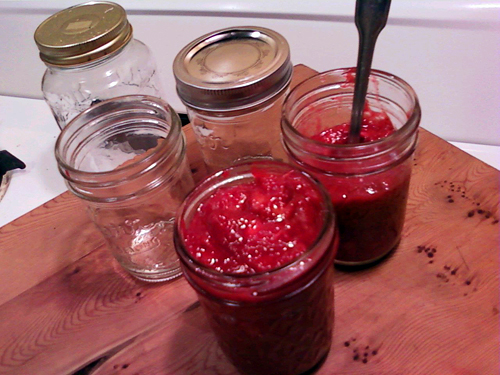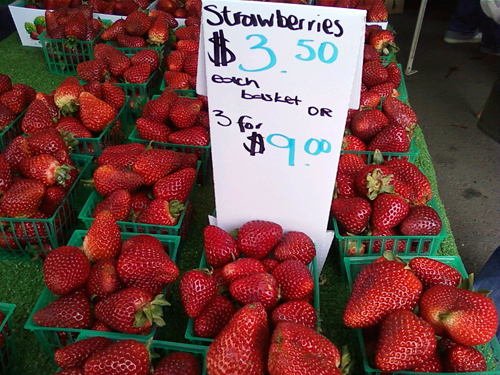And what you're not eating are those fancy jams. I also know this because, like most beginning jam makers, I used to make those kinds of jams, and give them to you as lovely house presents at any opportunity. The rum-brown-sugar-peach-nectarine preserves, I was so proud of them! The Meyer lemon chutney from food writer/novelist Laurie Colwin's recipe, carefully aged for a couple months just as she recommends. Blueberry with Cointreau, plums with Bordeaux: I made them, you accepted them with grace (thanks, Mom!) and then you hinted, ever so gently, that maybe you didn't want rum anything on your toast in the morning. What you wanted was what everyone wants: Strawberry jam. Apricot preserves. Blackberry jelly. Raspberry jam, straight up and tasting of summery sun-warmed fruit, with just enough sugar to round out the fruit's natural sweetness.
So these are the jams I make now, and if you want the recipients of your jam-making largesse to actually devour your wares with pleasure, rather than sadly leaving them on the shelf, testaments to more good will than good mornings, this is what you will do, too.
Start with the best and most-loved, strawberry jam. But not the easiest. For all its gingham-y, morning-in-America, come on in and sit right down and make yourself at home aura, the strawberry actually has some fussy little habits. For starters, pectin. Or the lack of it: strawberries are right up there with cherries in the low-pectin pantheon. Which means that unlike its high-pectin friend, the blackberry (which practically jams itself given a little sugar and a quick, frothing boil), strawberries need a little persuasion to form anything like a gel.
You could, of course, get a bottle of Sure-Jel or a packet of powdered pectin and make perfectly bounceable strawberry jam every time. I never do. There's nothing wrong with packaged pectin; it's a natural product, usually derived from apples or lemons. But a fruit mixture gels when the pectin is exposed to a particular ratio of sugar to acid. When you bump up the amount of pectin in the mix, you have to add a correspondingly large amount of sugar to make the science work. You'll get a firm set, but the resulting jam will be, to my taste, unremittingly sweet.
Anyway, there's no need. In my experience, you can make jam from just about anything using nothing more than fruit, sugar, and a lemon or two. Simple, easy, and spontaneous, depending on what's ripe in your backyard, your neighbor's yard or at the market.
So, back to our little diva princess, the strawberry. Her real friends are the best and oldest ones: sugar and time. But let me introduce her newest BFF, tart to her sweet, rosy pink to her ruby red. Yes, I'm talking about rhubarb, the prettiest pink stalk you ever did see. It's a perennial plant, growing from a crown and sending up long, celery-like stalks every spring that start out green and flush pink-red as the weather warms. The broad leaves look like spinach, but are mildly toxic and should never be eaten.
Sometimes called pie plant, rhubarb is one of the happiest harbingers of spring, arriving just as the first strawberries begin to appear in the market, a welcome tang of fruity pink at a time when the delights of local cherries and apricots are still a good month away. You can match rhubarb with strawberry in any ratio: a lot of rhubarb with just a few berries for sweetness, or plenty of strawberries with just a little rhubarb for texture and tartness. Which reminds me: if you've never had rhubarb before, you won't forget your first taste of it raw. Like sorrel, another lively spring arrival, it's tongue-twistingly sour.
Crunchy-firm when raw, rhubarb collapses when cooked into what can only be described as a lush stringiness. The easiest way to cook it is as a simple compote: chopped rhubarb tossed with sugar, left to sit for 15 minutes or so, then gently simmered until tender. If you're adding strawberries, just toss them into the rhubarb off the heat and let them soften in the residual warmth. It's good hot, cold, by itself, spooned over ice cream or mixed into yogurt.
After years of loving strawberry-rhubarb compote every spring, it seemed only natural to try adding some to my strawberry preserves. This would thicken up the runniness that these preserves can be heir to, while adding a dimension of fruity tartness.
For the first step, you'll need to macerate the strawberries in sugar for anywhere from 4 to 8 hours, i.e., overnight. You nip off the green hulls and cut up the berries--halves if small, quarters or smaller if large--and put them in a large glass or ceramic bowl. Sprinkle on the sugar, mix gently, cover and walk away. If it's very hot where you are, put them in the fridge, but otherwise, room temp is fine. Every couple of hours, if you think of it, give them a gentle stir to make sure the sugar is dissolving evenly.
By morning, the sugar will have draw out much of the liquid trapped inside the berries, and you'll have some slightly shrunken-looking berries floating in a lot of cough-syrup-red liquid. Add the juice of a lemon and the chopped rhubarb, then dump the whole thing into a non-aluminum pot. Bring to a simmer and let cook for 2 or 3 minutes, then pour back to the big bowl.
Cover again, this time with a clean dish towel so steam can escape, and let sit for another 4 to 6 hours. Look again, and you'll see some now majorly shrunken berries and cubes of rhubarb bobbing in even more, now slightly darker, red liquid. You're getting close now!
Now, here's the trick, and credit goes to the sublime Helen Witty, whose books Fancy Pantry and Good Stuff (now both out of print, but available at amazon.com or the library) are infallible resources for all kinds of pantry-stocking recipes.
So, put a colander over a large, preferably wide and short (rather than narrow and tall) non-aluminum pot. Dump in your strawberry mixture and let all the liquid drain into the pot. Set the fruit-filled colander aside, and bring the liquid to a boil. Let it boil vigorously for some 10 to 15 minutes, until the liquid has darkened and thickened to a syrupy consistency.
By subjecting the liquid, not the fruit, to the bulk of the boiling, the fruit stays fresh and vivid. Once the liquid has thickened, add the fruit and cook, stirring frequently, for another 3 to 5 minutes, until mixture has thickened and looks like jam. It's that simple, really.
Good as they are on toast, these preserves also make a wonderful addition to French toast. Take a thick slice of challah bread and cut a pocket into the side. Beat cream cheese until fluffy, adding honey and vanilla extract to taste. Spread a spoonful of cream cheese and a spoonful of preserves inside the pocket, then dip in a mixture of egg and milk. Fry in butter over medium heat until golden brown and gently puffed on each side. Serve with maple syrup or powdered sugar.

Photo by Stephane von Stephane
Strawberry Rhubarb Preserves
Makes 4 to 5 half-pint jars
Ingredients:
4 pint boxes strawberries, rinsed, hulled, and halved or quartered
2 to 2 1/2 cups sugar
1 lb rhubarb, trimmed and chopped
1 lemon, juiced
Preparation:
1. In a large ceramic or glass bowl, toss berries with sugar. Cover and let rest, stirring occasionally, for 4 to 8 hours.
2. Add chopped rhubarb and juice of 1 lemon to strawberry mixture. Pour into a large, shallow non-reactive pot. Bring to a simmer and cook for 2 or 3 minutes. Pour back into bowl, cover with a clean dishtowel and let rest for another 4 hours or so.
3. Set a colander over the same pot. Pour strawberry mixture into colander and let drain. Remove colander and set aside.
4. Bring liquid to a boil and let boil, stirring occasionally, for 10-15 minutes, or until liquid has thickened to a syrupy consistency.
5. Add fruit, reduce heat, and cook, stirring frequently, until fruit looks glossy and translucent and mixture has thickened to a softly jammy consistency, about 8 to 10 minutes. Remove from heat.

